Types of Email Marketing:
The 5 Emails That Actually Make You Money
Most businesses fail at email because they don’t understand the types of email marketing they should be using. They either blast random promotions until people unsubscribe, or they ghost their list and wonder why no one buys from them. The reality? Email marketing isn’t about sending more—it’s about sending the right emails at the right time.
There are five essential types of email marketing you need to master:
- ✅ Promotional Emails – The ones that actually sell stuff.
- ✅ Transactional Emails – The ones customers expect.
- ✅ Automated Emails – The ones that make you money while you sleep.
- ✅ Content Emails – The ones that build trust and keep people engaged.
- ✅ Response Emails – The ones that spark real conversations.
When you get these right, your emails stop feeling like spam and start working like a 24/7 sales engine. By the end of this guide, you’ll know exactly how to use each type—and how to stop sending emails that get ignored.
Let’s dive in.
Promotional Emails
Promotional emails are your money-makers—the ones that turn clicks into cash. But here’s the problem: most businesses screw them up. Either they go full-on infomercial mode with aggressive sales language (“BUY NOW! FINAL CHANCE!” every single day), or they’re too hesitant (“Hey, here’s a sale, if you maybe feel like checking it out?”). Neither works.
A great promotional email doesn’t just sell—it creates a buying moment. That’s the difference between sending an offer and driving action.
When to Use Them:
- Product launches – Introduce something new and make it irresistible.
- Flash sales – Create urgency and push conversions fast.
- Seasonal promotions – Tie your offers into key shopping seasons.
- Limited-time discounts – The quickest way to get hesitant buyers off the fence
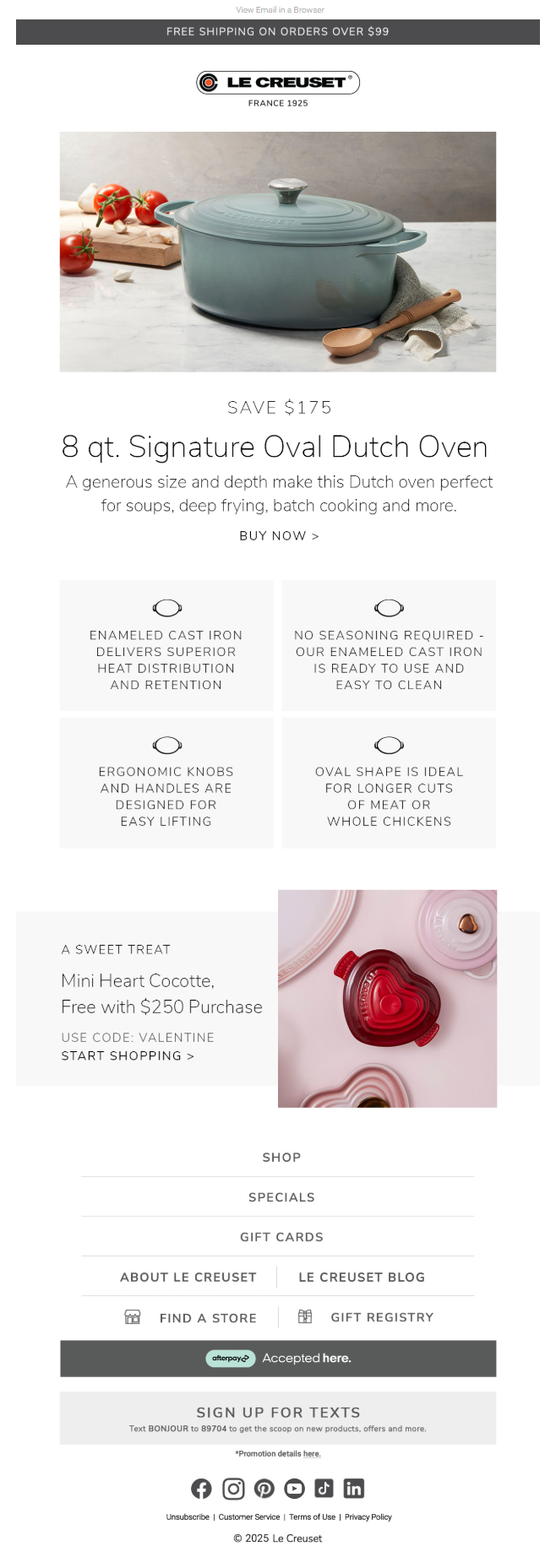

The Formula for a High-Converting Promo Email
Start With a Killer Hook
Forget the generic “We have a sale!” Your subject line needs to hit fast.
- Use numbers: “24 Hours Only – 30% Off Ends Tonight”
- Tap into emotion: “You Deserve This – 20% Off Just for You”
- Create intrigue: “The Deal You’ve Been Waiting For...”
Insider Trick: First name personalization? Overrated. Preview text (the small text that appears next to the subject line in inboxes)? That’s your secret weapon. Most people skim their inbox before opening anything. Nail the first line of your email, and you’ll boost open rates without needing gimmicks.
Make It Stupidly Easy to Buy
Once they open your email, don’t make them think.
- Big, clear CTA: “Grab Your Discount” (not “Learn More” or “Check it Out”)
- Limited text, big impact: Keep it short, scannable, and focused on why they need to buy now.
- Images that sell: If it’s a product, make sure they can see it in action.
Pro Hack: Add a second CTA link in the P.S. line. Some buyers scroll straight to the bottom—give them another shot at clicking.
Use Scarcity & Urgency (Without Sounding Like a Used Car Salesman)
- “24 hours only” converts better than “Here’s a sale.”
- “Price goes up at midnight” creates urgency without sounding pushy.
- Countdown timers in emails? They work—but only if they’re real. Fake urgency kills trust.
Secret Move: Set up a segmented “last call” email for anyone who opened but didn’t buy. That final reminder can double your conversions.
The Magic of Follow-Ups (97% of Businesses Ignore This!)
Most sales don’t happen on the first email. If you’re only sending one promo email, you’re leaving money on the table.
The best-performing promotions run a 3-Email Sequence:
- Email 1: The Announcement – “Big sale happening now!”
- Email 2: The Reminder – “Only 24 hours left to grab this deal.”
- Email 3: The Final Push – “Last chance—sale ends in 3 hours.”
- Email 4: The Extended Sale - "Our best price extended for one more day." (Use sparingly for your biggest sales)
Power Move: The final email should be short, direct, and urgent. No fluff, just click and buy.
How to Write Promotional Emails That Actually Convert
A good promo email doesn’t just announce a sale—it creates a buying moment. You need urgency, exclusivity, or scarcity to make people act now.
Here are five proven approaches:
1️⃣ Urgency-Driven – Deadlines make people act fast.
- “50% Off Ends Tonight—Don’t Miss Out”
- “This Sale Disappears at Midnight”
2️⃣ VIP Treatment – Make them feel special.
- “Private Invite: Unlock Your Exclusive Offer”
- “Early Access—20% Off Before Anyone Else”
3️⃣ Scarcity – Fear of missing out sells.
- “Only 17 Left—Grab Yours Before They’re Gone”
- “Once It’s Gone, It’s Gone: Last Chance to Order”
4️⃣ Loss Aversion – People hate losing deals.
- “Your Discount is About to Expire—Don’t Waste It”
- “You Could Be Saving $50 Right Now”
5️⃣ Pattern Breaker – Disrupt inbox fatigue.
- “Wait… Did You Forget This?”
- “This Deal is So Good, We Might Regret It”
A great promo email doesn’t just announce a sale—it makes them feel like this is their last chance to grab something valuable. Sell the moment, not just the discount.
Transactional Emails:
The Most Overlooked Trust Builder
Most businesses treat transactional emails like an afterthought—big mistake. These are the most opened emails you’ll ever send, and if you’re not using them strategically, you’re wasting valuable touchpoints with your customers.
What They Are:
Transactional emails are non-promotional emails triggered by customer actions, such as:
✔ Order Confirmations – “Your order is confirmed. Here’s what’s next.”
✔ Shipping Updates – “Your package is on the way!”
✔ Appointment Reminders – “See you tomorrow at 2 PM!”Why They Matter:How to Do It Right:
- Insanely High Open Rates – Customers expect these emails, meaning they actually get read.
- Branding Opportunity – A dull “Your order has shipped” email is a wasted chance to build trust and engagement.
- Reinforces Reliability – Clean, professional transactional emails make your brand look polished and put together.
✅ Don’t Be Boring. This is a branding moment. Make it sound like you, not a generic template.
✅ Cross-Sell Subtly. "Your order is on its way! Customers who bought this also loved [upsell product]."
✅ Keep It Clear, Fast & Useful. No fluff. Just tell them exactly what they need to know.
A transactional email isn’t just a receipt—it’s a trust-builder, a branding tool, and even a sales booster. Use them wisely.
Not all transactional emails are the same. Some email providers allow you to send pure transactional emails to customers who aren’t technically on your email list—meaning they’ve made a purchase but haven’t opted in for marketing. These emails are legally allowed because they serve a functional purpose (order confirmations, shipping updates, password resets) rather than marketing.
Key Difference:
- Transactional Emails: Essential, service-based messages triggered by customer actions. No marketing fluff.
- Marketing Transactional Emails: Look like transactional emails but include upsells, product recommendations, or branding elements.
Some platforms (like Klaviyo) separate these categories so you don’t risk violating email regulations like GDPR or CAN-SPAM. Make sure you’re using the right type for the right situation.
Automated Emails:
The 24/7 Sales Machine
If you’re still manually sending emails, you’re doing it wrong. Automated emails are your silent sales team that never sleeps—running 24/7 to turn leads into customers, recover abandoned sales, and keep buyers coming back without you lifting a finger.
What They Are:
Automated emails are pre-set email sequences triggered by specific user actions—so instead of blasting the same message to everyone, your emails feel timely, relevant, and personal.
Essential Email Flows to Set Up:
✔ Welcome Series – Turn new subscribers into customers by introducing your brand, setting expectations, and making an irresistible first offer.
✔ Abandoned Cart – Recover lost sales by reminding shoppers what they left behind (and sweetening the deal with an exclusive offer).
✔ Post-Purchase – Keep customers engaged after they buy with thank-you emails, product care tips, and cross-sell recommendations.
✔ Winback Series – Re-engage inactive subscribers and past customers with a compelling reason to return.How to Do It Right:
✅ Personalization is key – Automated doesn’t mean generic. Use their name, recommend products based on past behavior, and make emails feel like they were written just for them.
✅ Test and optimize – If it’s running 24/7, make sure it’s actually working. A/B test subject lines, CTAs, and timing to maximize conversions.
✅ Time it right – A “We miss you” email sent three days after a purchase? Awkward. Make sure automations are triggered when they make sense.
Automation isn’t just about saving time—it’s about making money on autopilot. Set it up once, optimize it, and let your emails do the heavy lifting. Click Here To Learn More About Email Marketing Flows.
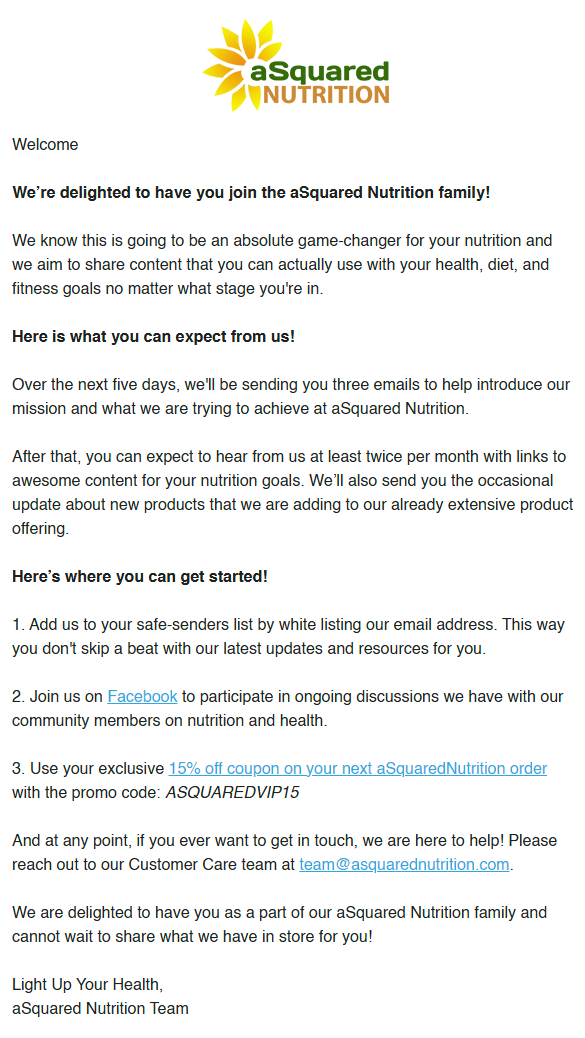 Typical Welcome Email
Typical Welcome Email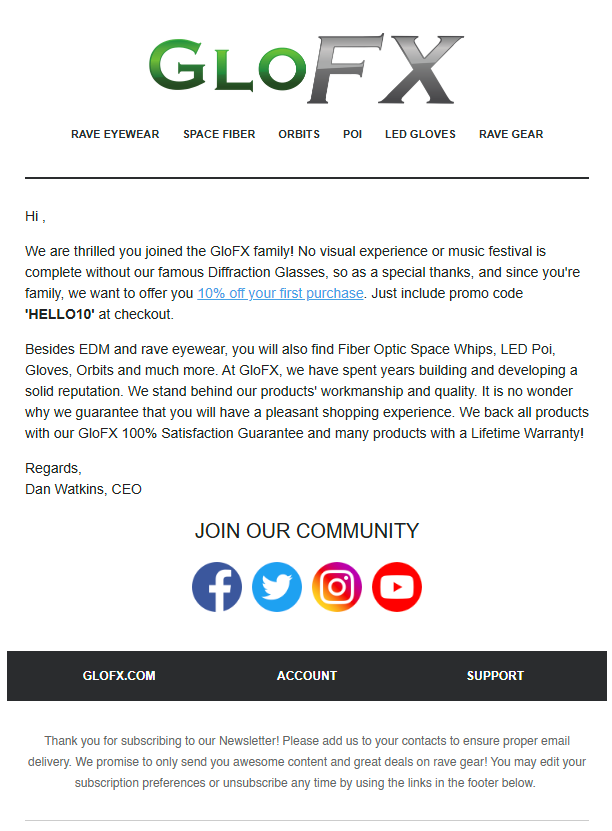 From the owner welcome email
From the owner welcome email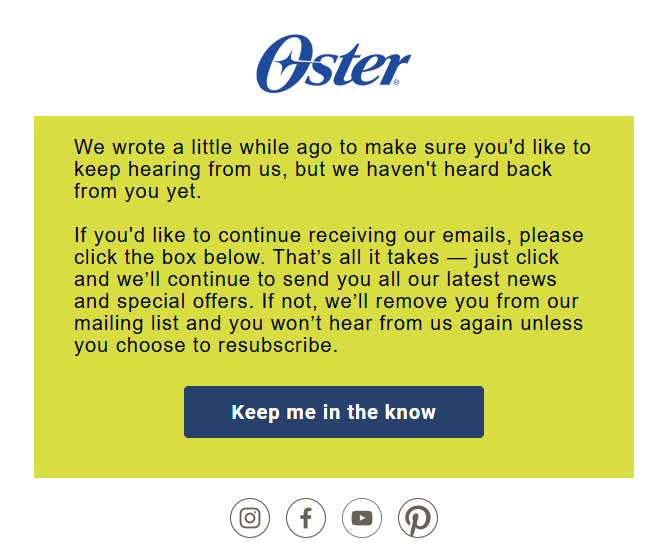 Winback/Reengagement Strategy Email
Winback/Reengagement Strategy EmailContent Emails:
Build Trust Before You Sell
If every email you send is a sales pitch, you’re doing it wrong. People don’t just buy from brands—they buy from brands they trust. And trust isn’t built by shoving discounts in their face every day. That’s where content emails come in.
What They Are:
Content emails are non-salesy emails designed to educate, entertain, or engage your audience—so that when it’s time to sell, they’re already primed to buy.Why They Matter:Types of Content Emails:
- If you only send promotional emails, people tune you out. Content keeps them engaged between offers.
- They position you as the go-to expert—the brand that provides value, not just another company pushing products.
- When done right, content emails make selling effortless—because your audience already sees you as the authority.
✔ Newsletters – Share insights, industry trends, or behind-the-scenes updates.
✔ Educational Emails – Tutorials, how-tos, and valuable tips that solve a problem.
✔ Storytelling Emails – Personal stories, brand journey updates, or customer success stories.
✔ Engagement Emails – Polls, quizzes, and open-ended questions that invite replies and start conversations.How to Do It Right:
✅ Make it interesting. No one wants to read another boring “industry update.” Add personality, a unique take, or something unexpected.
✅ Keep it short and skimmable. People don’t have time for an essay. Get to the point.
✅ Tie it back to your brand. Even when you’re not selling, content should reinforce why your business matters.
Content emails aren’t just filler—they’re the glue that keeps your audience engaged so that when it’s time to buy, they don’t hesitate. If you’re not sending them, you’re making every sale harder than it needs to be.
 A Content Email which focuses on engagement
A Content Email which focuses on engagement A content email that focuses on engagement and getting a response
A content email that focuses on engagement and getting a responseResponse Emails:
Spark Conversations and Boost Deliverability
Most emails are one-way—brands talk, customers listen (or ignore). Response emails flip the script. Instead of just pushing information, these emails invite subscribers to engage, reply, and start a conversation. And that’s a game-changer for both relationships and email deliverability.
What They Are:
Response emails are designed to get a reply. Whether you’re gathering feedback, re-engaging dormant subscribers, or starting a conversation, these emails turn passive readers into active participants—and that builds trust fast.Why They Matter:
✅ They make your brand feel human. You’re not just another faceless company—you’re starting real conversations.
✅ They boost deliverability. Email providers track replies as a positive engagement signal, meaning fewer of your emails end up in spam. When subscribers reply, it tells inbox providers that your emails are important.
✅ They drive engagement. The more someone interacts with your brand, the more likely they are to buy from you.
Types of Response Emails:
1️⃣ Feedback Requests
Ask customers what they think—about your products, services, or content. A simple “How’s your experience so far?” can open the door to insights and future sales.
2️⃣ SPEAR Emails (Short, Personal, Expecting a Response)
These are one-sentence emails that force a reply. The shorter, the better.
Example: “Hey [Name], are you still interested in [X]?”
🔥 SPEAR Emails Are Extra Effective for B2B
In B2B, inboxes are flooded with long-winded, impersonal sales pitches. A one-liner that feels direct and personal cuts through the noise—getting higher response rates than bloated cold emails ever will.
3️⃣ Survey Emails
Want to know what your audience really wants? Ask them. Keep surveys short and easy to complete, and give them a reason to respond (like a discount or exclusive insight).
4️⃣ Open-Ended Questions
Spark engagement by inviting customers to share their thoughts, struggles, or goals. This works especially well for service-based businesses or personal brands.
 A reply style email
A reply style email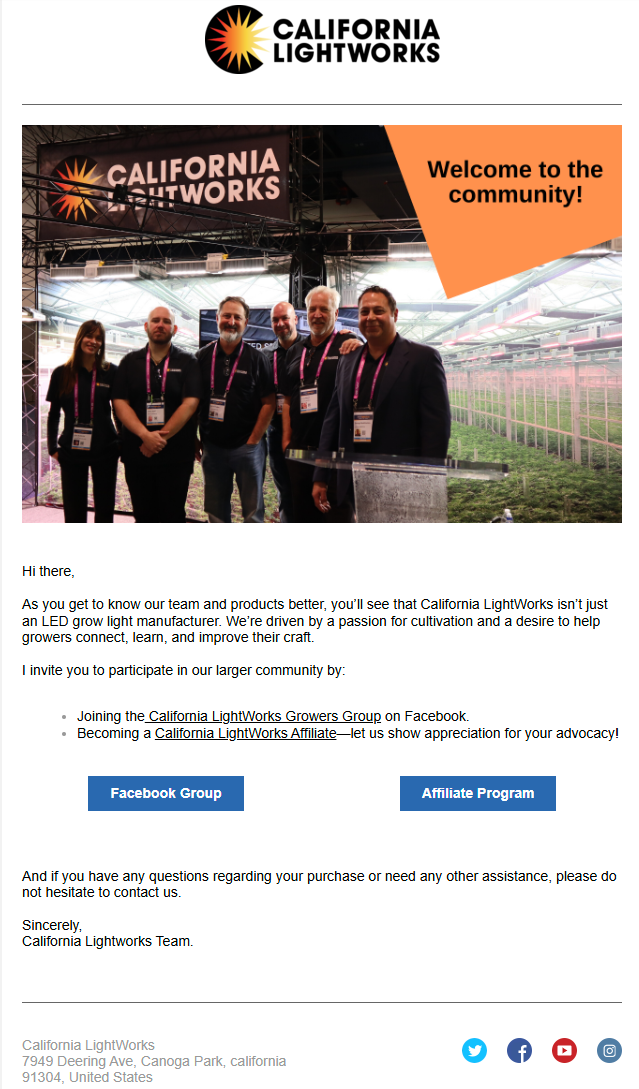 A community builder response email
A community builder response emailHow to Do It Right:
✅ Keep it short. Especially for SPEAR emails—the less they have to read, the faster they’ll respond.
✅ Make it personal. Write like a human, not a corporate bot.
✅ Ask one clear question. If you ask five things at once, you’ll get zero answers.
✅ Follow up. If they don’t respond, a quick “Just checking in” email can work wonders.
Response emails aren’t just about engagement—they strengthen relationships, boost deliverability, and make your brand feel real. Use them right, and you won’t just get more replies—you’ll get more customers and inbox priority.
Email marketing isn’t about blasting random messages and hoping for the best—it’s about sending the right type of email at the right time to drive real engagement and revenue. If you’re only sending promos or newsletters, you’re leaving serious money on the table.
✅ Promotional emails drive sales.
✅ Transactional emails build trust.
✅ Automated emails make you money while you sleep.
✅ Content emails keep people engaged so they actually open your promos.
✅ Response emails create real conversations and boost deliverability.
Mastering all five types of email marketing ensures you’re not just another brand in their inbox—you’re the one they actually pay attention to.
Ready to stop guessing and start making email work for you? Get expert help with a custom-built email system designed to drive revenue. Check out my Done-for-You Email Services or dive deeper into email marketing automation to start setting up the emails that will grow your business on autopilot.